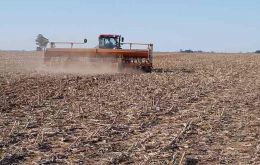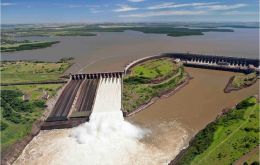MercoPress. South Atlantic News Agency
Tag: drought
-
Friday, December 11th 2020 - 08:40 UTC
Brazil lowers corn production forecast because of dry weather in the south

Brazil's corn production forecast for 2020-21 has been cut to 102.6 million mt from 104.9 million mt projected in November, Brazil's national agricultural agency, Companhia Nacional de Abastecimento (Conab), said in its latest forecast.
-
Saturday, November 21st 2020 - 08:49 UTC
US soybeans futures hit a four year high on dry conditions in key South American crop areas

U.S. soybean futures rose for a sixth consecutive session on Friday and hit a four-year high on dry conditions in key South American crop areas and concerns about dwindling U.S. supplies. Corn also gained on strong exports and worries about South American dryness, while wheat ended mixed.
-
Friday, October 30th 2020 - 18:06 UTC
Drought impacts on Argentine corn planting and overall production and exports

Corn production in Argentina is likely to drop to 48 million tons in 2020-21 from 50 million tons in 2019-20, the US Department of Agriculture's Foreign Agricultural Service in Buenos Aires said in a report released on Thursday.
-
Monday, October 26th 2020 - 09:50 UTC
Drought and wildfires devastating South America's wetlands and forests

Experts say the wildfires in a region that spans Argentina, Brazil, Bolivia, and Paraguay – especially the region between the Paraguay, Parana, and Uruguay rivers – have become critical in 2020.
-
Tuesday, September 15th 2020 - 09:19 UTC
Ecological disaster: fires destroying Brazil's wetlands suffering the worst drought in 47 years

Fires are raging in the wetlands of west-central Brazil, leaving behind a vast swath of charred ruins in a paradise of biodiversity. The enormous fires have destroyed nearly 12% of the world’s largest tropical wetland, partially reducing to ashes one of the most biologically diverse ecosystems on the planet.
-
Wednesday, August 26th 2020 - 09:50 UTC
Fires are raging in several Argentine provinces fueled by strong winds and persistent drought

Fires are raging in Argentina’s Cordoba province, prompting evacuations and threatening to destroy homes, fueled in part by strong winds and a lack of rain, officials said on Monday.
-
Wednesday, July 22nd 2020 - 08:00 UTC
Parana river insufficient water level benefitted exports from Brazilian ports

Due to the Paraná river drought, which affected Argentina’s soy oil-exporting capacity, Cattalini Terminais Marítimos, which handles almost 70% of Brazil’s soy oil exports through its facilities in the port of Paranaguá, predicts a 25% increase in shipments this year.
-
Friday, May 15th 2020 - 08:49 UTC
Next Monday Itaipu opens its spillway to help lift the drought stricken Parana river level

The world's largest operational hydroelectric dam, Itaipu Plant announced that starting next Monday, May 18, it will open its spillway to help Paraguay and Argentina, which are suffering from a drought and hence having problems transporting their grain harvest.
-
Saturday, April 18th 2020 - 19:56 UTC
Argentina and Brazil trying to lift the water level of the Parana River, in the heartland of the soy belt

The governments of Argentina and Brazil are in talks to release water from the giant Itaipu Dam with a view to topping up the Parana River, where ebbing levels are conspiring against a US$ 20-billion-a-year crop export business.
-
Tuesday, April 14th 2020 - 08:45 UTC
Parana river water level hampering grain transport in the midst of peak harvest

Below normal rains in the Parana-Paraguay water basin is hampering grain transport through waterways in Argentina as the water level of the river has dropped significantly, Bolsa de Comercio de Rosario, or BCR, said in a report.
